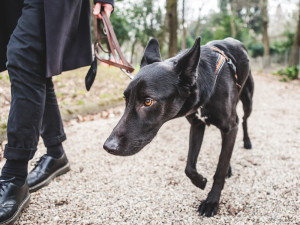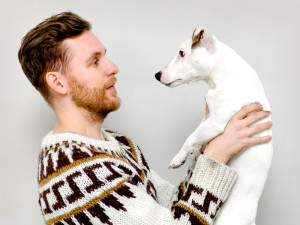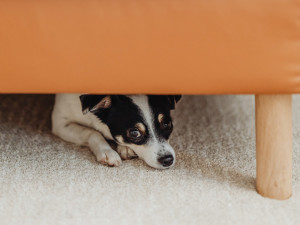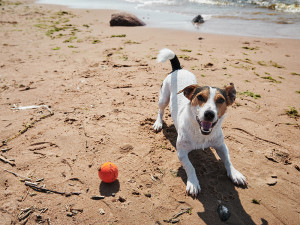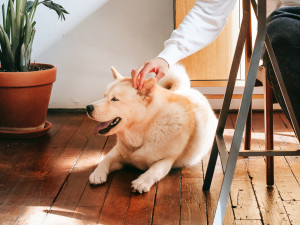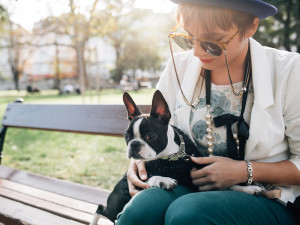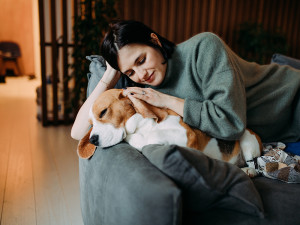Bringing Home A Very Nervous Rescue Dog – A Guide For Anxious Parents
At so many points in those first hours, weeks, months, I screamed, internally: what have we done?
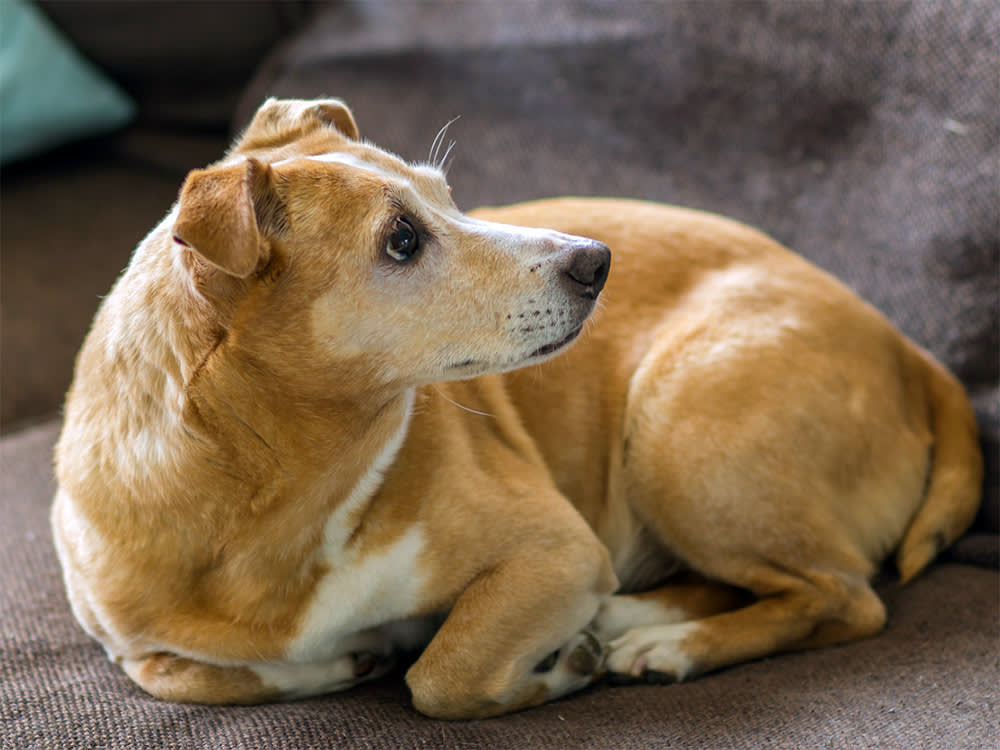
share article
When we first brought our rescue dogopens in a new tab Lucy back to her new home – my husband and I’s garden flat in south London – she was wild with fearopens in a new tab. ‘Be careful when you get her out of the car,’ the rescue had warned, ‘that’s when she’s likely to bolt’. She was so scared that she flailed around at the end of the lead and I gripped on to it as my husband opened the front door. How was Lucy supposed to know that we were guiding her into a safe new life?
Three and a half years later and Lucy couldn’t be more different to that terrified creature who felt like a stranger to us. But at so many points in those first hours, weeks, months, I screamed, internally: what have we done?
If that’s you right now, I promise this is a totally normal feeling, you will get through it and it will be oh so worth it. “It’s a natural reaction to the high emotions of the arrival of your new dog,” assures Susan Weller, who serves as homing co-ordinator at Give A Dog Homeopens in a new tab, the small charity we adopted Lucy from. “It’s a time many people give up…”
So here’s a guide with tips and advice for those who’ve adopted – or are thinking about adopting – a nervous rescue dog, covering everything from how to settle them in the first few days to guiding them safely into their new world.
The first few hours, days, weeks…
The first thing to remember is that all rescue dogs will be nervous on entering a new home – “but especially foreign dogs and puppy-farmed pups,” says Lynne Spencer, founder of Give A Dog A Home, which specialises in bringing foreign rescue dogs over to the UK. “They won’t have a clue what to expect.”
Lucy, for example, had been a stray in Greece, all we knew was that she’d come over in a van, four days in a cage, to be dropped off at the side of a road. I knew I needed to make her feel safe, so for those first few weeks I took time off from work and stayed with her. This is something that Rebecca Hanlonopens in a new tab, behaviour practitioner at Speak Dogopens in a new tab, which provides education for both trainers and owners, recommends to focus on getting to know your new dog. “Keep it nice and quiet,” she says, “just spend time with them.”
The first few hours and especially that first night can feel overwhelming – for you and the dog. “If you have a house with a (secure) garden, let them sniff around and open the back door,” advises Rima Chehlaoui, behaviourist at Even Better Dogs K9 Behaviour and Trainingopens in a new tab – a group of force-free trainers trainers who are members of The Pet Professional Guild British Islesopens in a new tab.
“You may want to keep the initial introduction to one room and the garden, then go from there.” Rima recommends scattering treats here and there for your dog to find and make sure that a bowl of water is in an obvious place. If your plan is for your dog to sleep separately from you, “consider sleeping in that room with them for the first night or two,” advises Rima, “then slowly transition them to being alone.”
And if they cower in the corner? “Leave them alone,” says Rebecca, “just like a child, you’ve got to go at their pace.” And although it’s tempting, try not to touch them. “Simply let them observe,” says Lynne. And if they come to you? “Gently stroke them under the chin, but never on their head.”
What is the ‘333 rule’ and should I follow it?
The 333 rule is a “guide to encourage adopters to take time, be patient and let their dog decide,” explains Lynne. It refers to the milestones your dog might reach in the first three days, three weeks and three months after you bring them home. Breaking it down, the timeline allows three days for your dog to decompress, three weeks to get into a routine and three months for them to feel settled.
“It suggests that for the first three days your dog may be overwhelmed, scared and not know what’s going on,” explains Rima. “The three-week mark suggests your dog will begin to feel more comfortable; their personalityopens in a new tab and character starting to show. The three-month stage might bring a bond with their humansopens in a new tab meaning they’ve gained a sense of security.” But Rima thinks that it’s much better to understand this as a ‘language’, and warns that your dog’s progression is fluid, rather than milestones being stamped in time. “A dog can go forwards and then regress and then move forwards again,” she explains.
“Nothing is definite,” agrees Lynne. It’s more useful to treat the 333 rule as a ‘minimum’. A dog who’s never lived in a home, for example, might take much longer than these timeframes. Lynne suggests that you might not even venture out of your front door for those first three days and definitely don’t introduce your dog to lots of new people or experiences. There’s no space for ego and expectations – the long walksopens in a new tab and fun will come later. “Don’t rush it,” says Lynne. “You have the rest of your lives together – curb your human enthusiasm and impatience to get on and make everything perfect.”
What your dog’s body is telling – the signs to look out for
Understanding your dog’s body languageopens in a new tab is the key to growing your bond – it’s how they talk to you. “Dogs can’t tap us on the shoulder and say, ‘errr, I hate that thing, it triggers me’,” says Rima. Some stress signs are more obvious, such as backing away, lowered body posture and being skittish. But there’s less obvious things your dog might do to let you know they’re unhappyopens in a new tab. “Panting, drooling and licking their lips, for example,” says Rima.
A lift of their paw can also be a sign of stress, as too is a turn of the head or a tucked tail, explains Rebecca. “It’s almost like they’re trying to get away from whatever it is.” Then there’s what Rebecca calls “stress reliever signs – like yawning and shake-offs”. It’s literally as if your dog is shaking off the intense energy of a situation.
And remember, says Rima, “Some rescue dogs have never experienced things that are mundane to us.” Think washing lines, vacuum cleaners, dishwashers, the beep of a microwave – the list goes on. “So if your dog backs away from something, don’t force them.” Very slowly and gradually expose them to these new things. “But make sure there’s an area they can retreat to when they need it – a space that’s just for them,” advises Rima.
The most important thing is that everything you do, “depends on the dog you have in front of you”, says Rebecca. You must look at who they are. “Perhaps you’ve rescued a Collie whose owner has died, they might want to play some gamesopens in a new tab with you.” Try throwing bits of food for them to seek out, then when they come back to you, mark it with a word such as ‘yes’. But if you have a very scared dog – particularly foreign rescues – “do nothing,” says Rebecca. “Never do anything that has a major expectation of an outcome.”
“Time, space, patience,” are the words you should keep in mind, according to Susan – not just in the first weeks of your dog’s new life, but forever. “The dog that walks in the door on day one is not the dog they will be three weeks or three months or even three years down the line,” she says. “Their personalities will emerge when they’re ready.”
And when that happens, the feeling is out of this world. Now when Lucy looks back at me for reassurance instead of lunging and barking in anxiety, I could burst with pride. “Good girl,” I tell her, as I give her a treat. Look how far we’ve both come…
Tips for settling a nervous rescue dog
Always praise your dog in a soft voice when they do something positive. “If you shout or use punitive methods it will just make them more fearful,” says Lynne.
“Get out of your own head and into theirs,” says Lynne. “It’s a wonderful, liberating exercise that will build empathy.”
Don’t take them for a walk until you think they’re ready, and when you do, keep it short. “Take them somewhere that’s not very busy,” says Rebecca. Lynne recommends simply sitting outside the front of your house so they get used to the new sounds and smells of their neighbourhood.
An Adaptil diffuseropens in a new tab releases pheromones that calm nervous dogs. “Plug them in near their sleeping area,” advises Rima. Pet Remedy is good for spraying on to their bedding or a neckerchief for those first few walks.
“Whatever you do, don’t take them to groomers in the first few weeks,” Rebecca says, “no matter how much they stink.”
Keep them on the same foodopens in a new tab they were eating in their foster home or rescue, if you can. “If you want to change it, wait until they’ve settled,” says Rima. “They’ve been through enough already. Then transition slowly over a couple of weeks, adding a little more of the new food each day and phasing out the old.”
Don’t start any formal training for the first few weeks, says Rebecca. ”Create a bond first.”
If you’re really worried? “Contact your rescue,” says Lynne. “They’re best to help as they know your dog.”

Alice Snape
Alice Snape is a freelance writer and editor whose work has featured in Cosmopolitan, Metro, Red, Vice, amongst other publications. Her rescue dog Lucy is the love of her life – probably because she’s an anxious weirdo like her. You’ll likely find them both curled up in bed – Alice’s favourite place to write from – or out having an adventure together in the park…
Related articles
![dog hiding under a couch afraid of noises]() opens in a new tab
opens in a new tabNoise Sensitivity and Pain in Dogs
Research finds why dogs may suddenly become super-sensitive to sounds
![Dog playing with orange ball toy at the beach on a sunny day]() opens in a new tab
opens in a new tabA Tail-Wagging Dog Isn’t Always a Happy Dog
This body language is not as simple as you probably think
![White dog laying on the couch looking guilty]() opens in a new tab
opens in a new tab“How Can I Train My Adult Rescue Dog to Stop Scent Marking All Over the House?”
Celebrity dog trainer Victoria Stilwell on how to keep your dog from using your living room as a toilet
![Unrecognizable man sitting at desk petting his dog]() opens in a new tab
opens in a new tabHow to Stroke a Dog – Yes, You Do Need Lessons
There’s a difference between being affectionate and being annoying
![Stylish woman sitting on a bench with her Boston Terrier dog.]() opens in a new tab
opens in a new tabHere’s Why Your Dog Is Terrified of New People
And how to change it
![Dog with sleep startle reflex. Woman lays on her couch and gently wakes up her dog]() opens in a new tab
opens in a new tabWhy Does My Dog Freak Out When I Wake Them Up?
‘Let sleeping dogs lie’ is more than just a proverb
